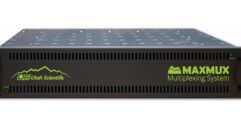Video Distribution Amplifiers
Jun 1, 2003 12:00 PM,
David Riffle
The majority of job bids today — whether for houses of worship, schools, boardrooms, residential or retail environments, or sports/entertainment facilities — require some (or a substantial) involvement with video technology. Even a simple install, such as a dental office, will entail video distribution to the waiting area and often individual ceilingmount displays showing programs to preoccupy the patient during procedures, particularly with children’s dentistry.
THE SYSTEMS APPROACH
Any facility involving video content is a combination of systems designed to collectively contribute to the communication goals of that facility. These systems are seldom isolated from each other, even if they’re performing very different tasks. Besides the programming content, the most important contributor to realizing any facility’s goal is the quality, performance, applicability, and interconnection of the equipment. Simply stated, the proper tools, properly applied, are the foundation of every facility. This is true whether you are outfitting a large facility or only a small installation.
Once you’ve determined the types of systems your installation requires, the next step is designing a plan to interconnect each system to form an integrated, effective technical foundation. This design should allow for each system to interchange signals with each other, to access any support equipment that is common to all systems, and to feed signals from any system to locations of remote control or viewing, such as control rooms, sanctuaries, or conference rooms.
Your design should allow technical personnel to monitor and evaluate the various program signals at the inputs and outputs of each system and at the various recording devices and should distribute consistent system output signals to each required location. The tech personnel should be able to access signal source equipment for service, without disrupting the integrity of any other device in operation at the time. This means that if a VTR is powered off or the reference input is disconnected, there will be no effect on the performance of any other equipment in the facility.
Many systems address the need for multiple signal destinations at the same time by providing multiple equipment outputs. Some of these systems also have a looping program signal and sync reference input, so there will be a convenient way to feed these signals to more than one destination at once. This approach increases the vulnerability of signal integrity by adding multiple cables and connectors in the path and does not permit the equipment to be disconnected — or, in some cases, even switched off — without disturbing or interrupting the signal path to other devices. So this approach is best left for small installations that use only one system and where any possible disruptions it generates are acceptable. For the larger installation, multisystem facility, or small installation that cannot afford to be out of service if some of the support equipment is disconnected, a much better solution is to use video distribution amplifiers (VDAs).
THE VIDEO DISTRIBUTION AMPLIFIER
VDAs are used to simultaneously distribute a video signal to a number of destinations. Some also offer signal conditioning or signal path compensation. In the process of performing these tasks, they provide signal gain, stabilization, input and output buffering, and many times, cable equalization compensation. They are available for digital as well as analog signals and in self-contained (standalone) or frame-based rackmount configurations.
VDAs are among the less glamorous components in any video installation but are one of those nuts-and-bolts components that can make the difference between success or failure in a facility’s technical infrastructure. Improper selection or application of VDAs can result in intermittent signal failures, system timing errors, signal measurement errors, and program signal quality errors and glitches.
The theoretically ideal VDA would have no unintended impact on the input signal. To approach this goal, it needs a very high input impedance if the line is not to be terminated at the VDA (low amount of loading on the signal input line) and a high-quality return loss specification (low amount of reflected signal). There should be an input loop through connection, which would allow the input signal to continue unaffected or receive a precision termination at this point, depending on whether the VDA is simply accessing the signal line or terminating it. Signal gain and cable equalization should be provided, as well as reclocking in the case of a digital signal, so that any losses the input signal has already sustained can be remedied. The VDA outputs should be highly isolated from each other and identical in amplitude, phase, and impedance to each other as well as the input signal.
Bandwidth is a measure of the range of frequencies that the VDA can pass without significant loss of gain. This rating is usually determined at the frequency that amounts to a loss of gain between the input signal and output signal of 3 dB. The higher the highest frequency and the lower the lowest frequency that meet this specification, the better. The output signal bandwidth should be at least five times greater than the input signal bandwidth to prevent attenuation or distortion of the output signal (the bandwidth of composite NTSC video is about 5 MHz).
In practice, though, not every application will require a VDA with all of these features. If input signal paths are short, cable equalization and gain adjustments may not be needed or even desirable. If the input signal is a monitor signal and will not be looped to any additional destinations, there is no pressing need for a looping input or an external termination. Reclocking on digital VDAs is generally desirable, but again if the input cable feed is short and the signal does not loop to additional destinations, reclocking is not a critical feature. Bandwidth, output isolation, stability, and input return loss are always important, though, and should never be sacrificed. Return loss is a measure of the input signal reflected back upon itself as a result of poor device input impedance matching, whereas output isolation is a measure of the amount of signal crosstalk between the outputs. In both cases, the lower the rating (as a level expressed in decibels below the main signal level), the better the performance.
Every video installation, large or small, must have a strong synchronization design, with equally strong implementation. Each timed system should use the same point in time as a reference. System timing adjustments are made relative to this point in time and do not need to also compensate for any preexisting inherent cabling delays. Analog facilities have a critical need to maintain signal timing coherence for the many source signals that are routinely manipulated, whereas digital facilities have greater flexibility in this area of concern. Digital facilities do, however, have a limit to that flexibility, which is usually determined by the design specifications of the individual equipment systems themselves.
So one of the most common roles of VDAs is to distribute a timing signal from a single source to each equipment system component capable of synchronized operation. That requires that the VDA have excellent return loss and output isolation specifications. Although most devices are fairly tolerant of signal level and distortion on their analog reference inputs, most depend on extracting a clean subcarrier from the reference signal (in the case of black-burst reference inputs). The subcarrier is the highest frequency component of this type of reference signal, and it will be the most adversely affected by return loss reflections and poor line termination. In the case of a digital signal, return loss reflections will dramatically interfere with the stability and integrity of the input signal by increasing signal jitter and high-frequency rolloff.
Another place that VDAs often prove indispensable is where there is a requirement to monitor a video signal in several different locations at the same time. Usually, this occurs during a live production, in a control room, in a client-supervised edit suite, or in any situation where people in separate locations must view the same program feed and coordinate decisions or activities with each other. As a VDA forms a buffer between the signal source and any of its destinations, it is an excellent way to tap into a main program signal path for the purpose of monitoring. In this application, the VDA must also possess a wide bandwidth and have a high degree of stability.
Used to fan out a main program signal path to multiple destinations, the VDA’s capability to compensate with gain restoration and HF rolloff correction encountered in long distribution paths is important. This is particularly true in the case of digital signal paths, because the additional degenerating factor of signal jitter can also be corrected by a well-designed VDA with the ability to “reclock” the input digital signal. For this application, in addition to the best of all of the above characteristics, the VDA will also need to have gain and equalization compensation and, in the case of a digital VDA, reclocking ability (jitter compensation).
PRACTICAL SELECTION
There are several VDA types designed for the diversity of various applications. Commonly, these types are differentiated by terminology such as utility VDA, EQ VDA, reclocking digital VDA, high-bandwidth VDA, and pulse VDA. The feature set determines which type a VDA falls under.
Obviously, a better physical and electrical design used to construct a VDA results in improved longevity and durability under difficult environmental conditions. Although not as obvious, other techniques that can add to high quality and reliability include the VDA’s type of input coupling, termination, and flatness of output bandwidth over the signal bandwidth range. For VDAs intended for high-frequency signals, the construction and impedance of the input and output connectors are carefully controlled. Normally, DC coupling provides the greatest signal bandwidth throughput, and a precision terminated input provides the greatest degree of level accuracy. The flatness of the output bandwidth over the signal bandwidth range can be even more important than the overall bandwidth of the VDA.
The power supply is vital to the stability of the VDA, and rackmount VDAs should have a more capable supply. This is because a high-quality supply can be used to power an entire frame full of modules, making this an economically viable design, whereas a standalone VDA may use a lower-quality power supply for the sake of budget economy and size constraints.
Once you have selected a VDA with high-quality technical specifications and the proper set of features for your application, the final concern is whether it will be grouped with a number of other VDAs or other similar components that will let it be mounted in an equipment rack or will need to operate in a standalone configuration on a desktop or another such location closer to a set of signal destinations.
STANDALONE VDAS
When space is an issue or when a set of signal destinations is far removed from the source, a standalone VDA is a good choice. Dozens of companies make good standalone VDAs. The supplier list accompanying this article lists a variety of manufacturers making VDAs of every style, type, and price range imaginable, ranging from compact “stick-on” accessories to bulletproof rack enclosures. Rather than go through each of the hundreds of models available from these companies, which could easily fill several issues of S&VC, I provided Web addresses for each manufacturer, so you can explore on your own.
To keep within S&VC‘s spatial confines, I’ll begin by examining several representative examples of high-quality, standalone VDAs.
AJA Video Systems makes some robust, standalone VDAs that are useful where space is at a premium and the environment is either difficult or a low profile is required. Its model D5DA is an SD SDI auto EQ VDA with reclocking, and the HD5DA is an HD SDI auto EQ VDA that can accept SD SDI signals, as well.
Altinex makes a number of standalone VDAs for composite, component, and VGA video. These are rather compact in size and are meant to solve distribution problems associated with computer displays and video monitors in an area reasonably close together. Altinex also makes some rackmount devices and some specialized versions of a VDA that are meant to be used as line drivers to extend the signal path without excessive loss. The DA1226AT is a versatile VDA that can pass computer RGBHV, RGBS, video, or S-video signals to HDTV resolutions. The DA1905GL is a VDA for RGBVH high-resolution signals and is an example of a line driver or buffer amplifier. This model is of great use in long signal paths.
Burst Electronics has several models, with and without EQ compensation. It also has a microsize model for difficult space restrictions. This model, the VDA-2EQ, has switch-selectable input termination and is completely protected from open or short circuits on the outputs, making it particularly suitable for use in harsh environmental conditions. An interesting variant on the standalone concept is the VDA-PC model, which is a VDA that is on a PC card, using the PC for power and cooling instead of a separate housing.
Comprehensive Video Group has a wide assortment of VDA offerings for video and computer displays. Some of these models are very high resolution meant for computer displays capable of HDTV image resolutions. The CVG-DA2CS model is a video or an S-video and stereo audio VDA, with gain and EQ adjustments for each. The CVG-VP6XL is a computer-display VDA capable of resolutions as high as HDTV, and the CVG-20ARII is an even higher-resolution video and stereo audio DA with as many as 20 outputs. It has four inputs and can be programmed to be as many as four individual DAs, each with five outputs.
Extron Electronics has a considerable selection of VDA models for analog and digital video and computer displays. The company’s Web site has a self-help guide to assist you in determining how its models are categorized and used and includes an excellent cross-reference for proper selection and comparison. Extron has rackmount versions, as well. Its DA6 YUV A is an example of a standalone or rackmount unit, capable of HDTV component distribution. The D/2 DA4 DVI model is a digital VDA intended for DVI computer and high-end consumer display interfaces.
Video Accessory Corp. literally has hundreds of choices, including what it lists as Mini Function Blocks, which are designed to be hardwired into equipment when space is limited. A large number of its VDAs can be custom ordered.
The Xantech Corp. has a VDA meant to supplement its line of home-theater accessories. Xantech’s Web site has a nice guide to various system applications for the equipment it makes. The AV61 is an analog video as well as a stereo audio combination DA, specifically designed for consumer equipment interfaces.
MODULAR RACK SYSTEMS
When it’s possible to place the VDA in a concentrated equipment room or when the set of destinations are widely dispersed from each other, a modular VDA makes a lot of sense. Such systems typically include a rackmount frame or card cage that allows the contractor to custom configure the system with plug-in modules or cards to provide the exact I/O and format and performance specs required by any installation. Here are some representative models of this genre.
Ensemble Designs has a range of VDA models that are meant for use with its Avenue frame system. This frame has an optional touch-screen control display or network control if connected and the control module is used. That allows adjustments to be made at the signal destination while the equipment frame is located at a distance, usually in another equipment room. VDA models include a mix of digital SD SDI and HD SDI with reclocking and EQ. The 5125 is a dual-channel SD SDI VDA with auto EQ and reclocking, and the 7100 is an HD SDI VDA with auto EQ and reclocking.
Evertz Microsystems has several VDAs for SD SDI and HD SDI as well as one for analog video for use with its 7700-series frame. This frame also allows remote control and adjustment of the VDAs. There is even an optional standalone enclosure for the VDAs in this series. The 7700ADA is an economical analog general-purpose VDA, and the 7700DA is an SD SDI version with auto EQ and a particularly versatile range of input signal rates from 19.4 Mbs to 540 Mbs.
Leitch provides an array of VDAs for utility and program path distribution. These include models with gain and EQ compensation and are intended for use in low-profile frames as well as higher-density 3 RU frames. These frames are designed to accept a mix of modules performing different tasks. Leitch also makes a standalone enclosure, called a Mixbox, that accepts any of its 600-series VDAs, which affords the opportunity to have a set of VDAs of the same type and consistency in use throughout a facility, which can be used in either a modular rack frame or standalone configuration. The VDA-683 is an example of a VDA with gain adjustment and a differential input to minimize hum and noise on the input. The VEA-684 adds input EQ and can be configured for AC or DC input coupling.
Miranda has two model series of VDAs for two types of frames with a good choice of gain, EQ, and reclocking models. Several models can be remotely monitored and adjusted if the appropriate control modules are installed in the frame and that frame is connected to a network or an external PC. The VEA-1021 model is capable of auto EQ on its analog input and remote control in the Densité frame. The SDA-1111 is an SD SDI VDA with reclocking and EQ, and the HDA-1812 is the HD SDI version. Miranda’s picoLink line also provides the SDA-172p, a standalone SD SDI VDA in a miniature form.
NVision makes VDAs for a number of applications within a facility. Most are digital VDAs with or without reclocking, and several are meant for HD SDI signals that can also pass SD SDI signals. The SD4110 is a simple fan-out VDA for SD SDI that provides digital auto EQ but without reclocking. The SD4111 is the reclocking version. For HD SDI, the SWB4211 is capable of auto EQ and reclocking and will pass SD SDI signals without reclocking. There are two different series of frames and, therefore, two different model series of VDAs. These frames are also designed to accept a mix of modules performing different tasks.
THE BOTTOM LINE
The quality of any installation is only as good as its weakest link, and the choice and use of basic, less glamorous infrastructure components — such as wiring, connectors, and VDAs — play a major role in determining the quality of the overall presentation. The proper selection and application of the right video distribution amplifiers for your requirements will go a long way toward assuring the technical soundness of your installation.
David Riffle, CSTE, is the chief technology officer of Video Arts, a digital video production facility in San Francisco.
For More Information
AJA Video Systems
www.aja.com
Ž 217
Altinex
www.altinex.com
Ž 218
Blonder Tongue
www.blondertongue.com
Ž 219
Burst Electronics
www.burstelectronics.com
Ž 220
Cable Electronics
www.cable-electronics.com
Ž 221
ChannelPlus
www.channelplus.com
Ž 222
Comprehensive Video Group
www.compvideo.com
Ž 223
Covid
www.covid.com
Ž 224
Digital Media Labs (DML)
www.dmlweb.com
Ž 225
Dwight Cavendish
www.philip-cooke.com
Ž 226
Ensemble Designs
www.ensembledesigns.com
Ž 227
ESE
www.ese-web.com
Ž 228
Evertz Microsystems
www.evertz.com
Ž 229
Extron Electronics
www.extron.com
Ž 230
FOR-A
www.for-a.com
Ž 231
FSR
www.fsrinc.com
Ž 232
Horita
www.horita.com
Ž 233
HRS Technologies
www.hrstechnologies.com
Ž 234
Inline
www.inlineinc.com
Ž 235
J. W. Davis and Company
www.jwd.com
Ž 236
Kramer Broadcast
www.kramerelectronics.com
Ž 237
Laird Telemedia
www.lairdtelemedia.com
Ž 238
Leitch
www.leitch.com
Ž 239
MicroImage Video Systems
www.mivs.com
Ž 240
Miranda
www.miranda.com
Ž 241
NVision
www.nvision1.com
Ž 242
Ocean Matrix
www.oceanmatrix.com
Ž 243
Panasonic
www.panasonic.com/pbds
Ž 244
Radio Design Labs (RDL)
www.rdlnet.com
Ž 245
Sierra Video Systems
www.sierravideo.com
Ž 246
Sigma
www.sigmaelectronics.com
Ž 247
Sign Video
www.signvideo.com
Ž 248
Video Accessory Corp.
www.vac-brick.com
Ž 249
Videotek
www.videotek.com
Ž 250
Xantech Corp.
www.xantech.comŽ 251
Ž Circle this number on Reader Service Card or visit freeproductinfo.net/svc










